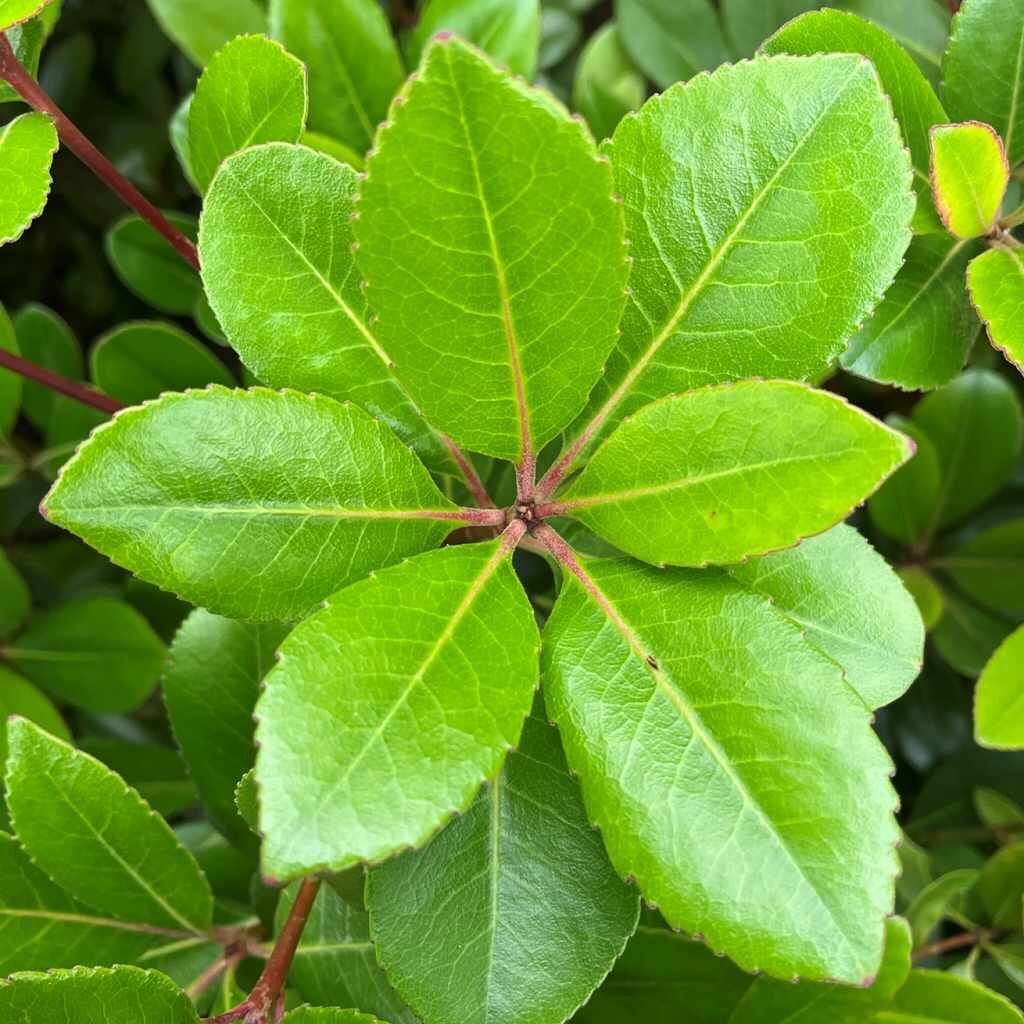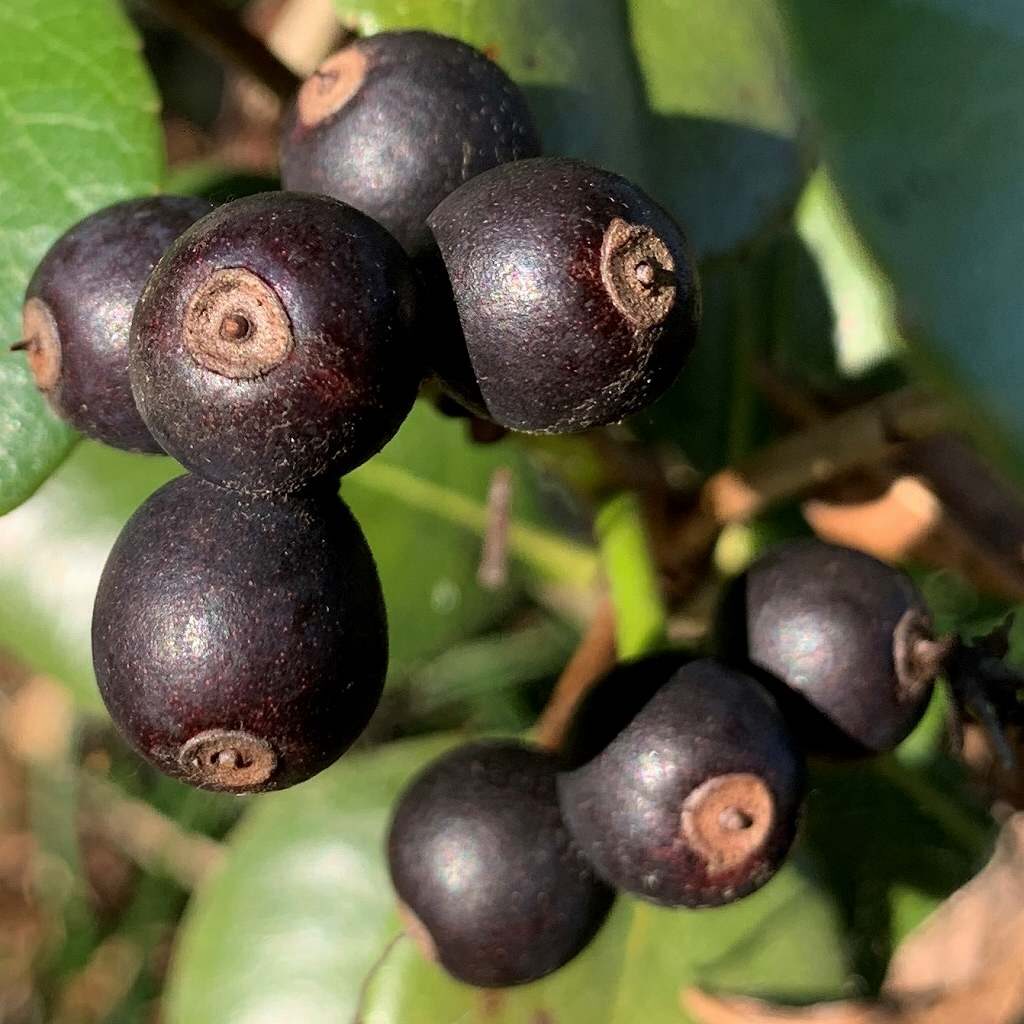シャリンバイは花言葉が「そよ風の心地よさ」「愛の告白」「純真」。車輪のような葉の着き方と、梅のような花々と香りが和名の由来です。
The flower language of Japanese hawthorn is “comfort of the breeze,” “confession of love,” and “innocence.” The Japanese name comes from the way the leaves are attached like wheels and the flowers and scent like plums.
【仮名】シャリンバイ
【和名】車輪梅
【英名】Japanese Hawthorn, Indian Hawthorn
【学名】Rhaphiolepis indica
【誕生】03/ 07
【開花】04, 05, 06月
【花色】White, Pink






シャリンバイ
シャリンバイの生態
シャリンバイはバラ科の常緑低木です。南アジアから東アジアにかけて15種ほど分布し、日本では温暖な沿岸地域に自生。花の外観は梅に似ていて白色と桃色があります。艶のある葉が美しく、刈り込みにも耐えるため庭園に植栽。樹体が枝葉に覆われるので生け垣にも用いられます。
シャリンバイの花
シャリンバイの花は萼片が5枚、花弁が5枚、雌しべの花柱が2つ、子房が2室、雄しべが20本前後。梅の花のような香りがあります。花後は丸い果実を結び、黒紫色に熟しますが、果肉が固く渋味もあり、食用には不向き。花言葉は「そよ風の心地よさ」「愛の告白」「純真」です。
シャリンバイの葉
シャリンバイの葉は肉厚の長楕円形。品種によって丸みを帯びたり、縁に浅い鋸歯が入ります。葉色は光沢のある深緑。低温で紅葉することもあります。枝先は単葉が集まって互生し、輻のような放射状。この車輪のような葉の着き方と、梅の花のような外観と香りが和名の由来です。
シャリンバイの変種
シャリンバイは変種に富むため、それらと区別して「立車輪梅」とも呼ばれます。変種は、葉が丸みを帯びて、枝が横に広がる「丸葉車輪梅」、逆に葉が細く、少し尖っている「細葉車輪梅」、葉の小さな「姫車輪梅」、花が薄桃色の「紅花車輪梅」など。これらの中間種もあります。
シャリンバイの利用
シャリンバイは潮風に強いので、海岸に近い公園などにも植栽。暑熱や乾燥、大気汚染に強いので、道路脇の分離帯などにも植栽されます。一方、鹿児島県の奄美大島では、車輪梅の木から煮出した液を絹糸に染めつけ。田んぼの泥水で色止めし、黒褐色の「大島紬」を織り上げます。
Japanese Hawthorn
Japanese hawthorn is an evergreen shrub of the Rose family. About 15 species are distributed from South Asia to East Asia, and grow naturally in warm coastal areas in Japan. The appearance of the flowers is similar to plums and is white and pink. The glossy leaves are beautiful and are planted in the garden to withstand pruning. Since the tree is covered with branches and leaves, it is also used for vegetation.
The flowers of Japanese hawthorn are 5 halves, 5 petals, 2 female stalks, 2 ovaries, and about 20 squirrels. It has a scent like plum blossoms. After flowering, it bears round fruits and ripens in black-purple, but the flesh is hard and astringent, making it unsuitable for food. The flower language is “comfort of the breeze,” “confession of love,” and “innocence.”
The leaves of Japanese hawthorn are thick and oblong. Depending on the variety, it may be rounded or have shallow serrations on the edges. The leaf color is shiny dark green. The leaves may turn red at low temperatures. At the tip of the branch, single leaves gather and alternate, and they are radial like radiation. The Japanese name is derived from the way the leaves are attached like wheels and the appearance and scent like plum blossoms.
Because Japanese hawthorn is rich in varieties, it is also called “standing wheel plum” to distinguish it from them. Variants include “round leaf wheel plum” with rounded leaves and horizontal branches, “thin leaf wheel plum” with thin and slightly pointed leaves, “princess wheel plum” with small leaves, and flowers. Light pink “Red Flower Wheel Plum” etc. There are also intermediate species of these.
Japanese hawthorn is strong against the sea breeze, so it is also planted in parks near the coast. Since it is resistant to heat, dryness, and air pollution, it is also planted in the separation zone on the side of the road. On the other hand, in Amami Oshima, Kagoshima Prefecture, the liquid boiled from the Japanese hawthorn tree is dyed on silk thread. The color is fixed with muddy water in the rice fields, and the black-brown “Oshima Tsumugi” is woven.


